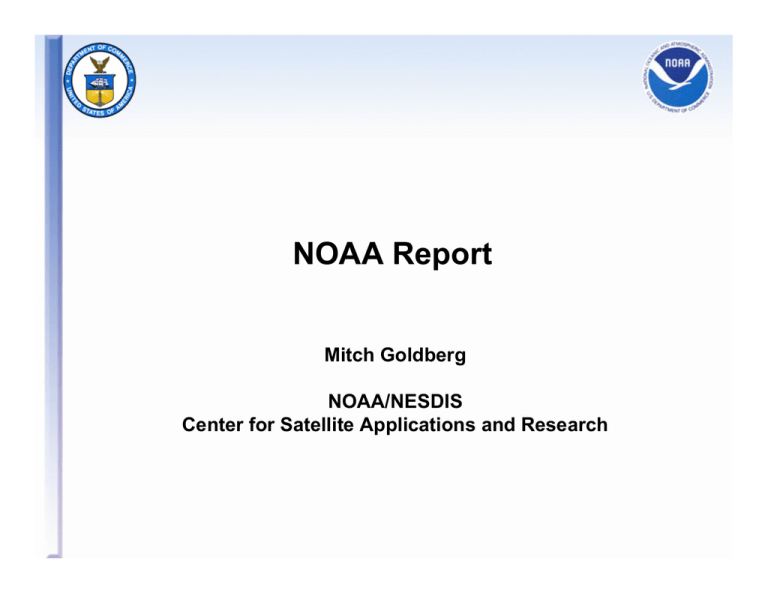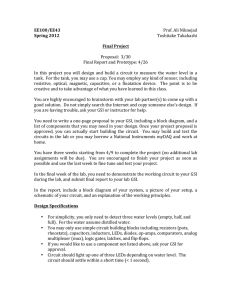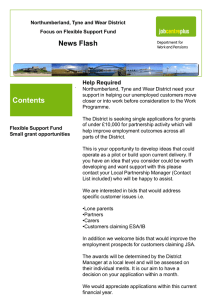NOAA Report Mitch Goldberg NOAA/NESDIS Center for Satellite Applications and Research
advertisement

NOAA Report Mitch Goldberg NOAA/NESDIS Center for Satellite Applications and Research NOAA JOINT POLAR SATELLITE PROGRAM Mission Support to NOAA Programs • Ecosystems – NOAA CoastWatch Program • Real-time distribution of regional SST, Ocean Color and Ocean Winds – Coral Reef Watch Program • Climate – Integrated Climate Data Record Program • Improved calibrated radiances • Time Series of Ozone , Vegetation Condition (Drought), Hydrology, Temperature, Moisture, Radiation Budget, Clouds, Aerosols, and Carbon – Reanalysis Project • Data assimilation algorithms • Radiative transfer models Mission Support to NOAA Programs • Weather and Water – Joint Center for Satellite Data Assimilation • Radiative transfer models • Surface emissivity models • Improve utilization of hyperspectral infrared radiances and microwave radiances • Satellite Derived Winds • Surface conditions – Hazards • Air Quality • Forest Fires/Biomass Burning • Commerce and Transportation – Aviation Weather Satellite Applications • • • • Clear-sky turbulence Convective cloud conditions Icing Volcanic Ash Key Activities • NPOESS • Processing systems for MeTOP and NPOESS Data Exploitation • GOES-R Algorithm and Cal/Val Effort • Integrated Cal/Val Enterprise Systems – Includes both radiance and products • WMO Global Space-based Calibration System (GSICS) • JCSDA • Climate Data Records • Air Quality METOP and NDE • Use integrated approach in algorithm development and validation – Same algorithms to process AIRS, IASI, and CrIS – Same algorithms to process AMSU, SSMI, SSMIS, ATMS • Completed processing system for IASI radiance distribution • Developing IASI level 2 processing – includes trace gases • Begin to develop CrIS and ATMS processing systems CrIS/ATMS Product System IT System Architecture Operational NCEP forecasts radiosonde Distribution User System(s) NCEP, FNMOC, AF, UkMO,ECMWF… Backup P5+ Node Radiance Products* SDRs P5+ Node IDPS T(P), Q(P), O3(P) CO2, CH4, CO Radiance Products* Cloud Cleared Radiances using clear VIIRS radiances and ATMS Principal Component Scores for noise filtering Validation CLASS CrIS/ATMS/VIIRS Product System is part of the NESDIS Advanced Product Roadmap Temperature & Moisture Products AIRS Regression (red), AIRS Physical (blue), ECMWF (yellow) vs. radiosonde AIRS minus TMI Total Precipitable Water AIRS vs TMI AIRS Performance 1K per 1 Km layers < 20% per 2 km layers AIRS measures multiple gases (and temperature, moisture and cloud products) simultaneously • 29 month time-series of AIRS trace gas products: Alaska & Canada Zone (60 ≤ lat ≤ 70 & -165 ≤ lon ≤ -90) • July 2004 Alaskan fires are evident in CO signal (panel 2) • Seasonal methane may be correlated to surface temperature (wetlands emission?) • CH4 CO CO2 O3 We have begun to investigate correlations that should exist between species (e.g., O3, CO, CH4 interaction) CH4 & Tsurf 29 month time-series of AIRS products South America Zone (-25 ≤ lat ≤ EQ , -70 ≤ lon ≤ -40) Biomass burning Microwave Integrated Retrieval System MIRS Capability SDR/EDR POES/METOP AMSU-A/B; MHS DMSP SSMIS NPOESS ATMS Radiances 9 9 9 Temp. profile 9 9 9 Moist. profile 9 9 9 Total precipitable water* 9 9 9 Hydr. profile 9 9 9 Precip rate* 9 9 9 Snow cover* 9 9 9 Snow water equivalent* 9 9 9 Sea ice * 9 9 9 Cloud water* 9 9 9 Ice water* 9 9 9 Land temp* 9 9 9 Land emis* 9 9 9 Soil moisture 9 * - Currently produced through MSPPS ** - Ocean surface parameters are intermediate products and not produced operationally through MIRS • Cross-Sensor Intercomparison – Comparison of advanced products from AMSU/MHS and SSMI/S (TPW images below) Note: wider AMSU swath than SSMI/S Our Vision: Sounding Products System MIRS to provide front-end retrievals for the robust first guess to infrared sounding system (HIRS, hyperspectral) MIRS AMSU A/B(MHS) ATMS SSMIS Integrated Validation System INFRARED Sounder/Imager HIRS, AIRS, IASI, CriS,HES AVHRR, MODIS, VIIRS,ABI NPOESS vs. GOES-R Process • NPOESS acquisition strategy is for the System Prime to be responsible for algorithm development, calibration/validation, and the development of the operational product generation system. • For GOES-R, the process was changed whereby the Government provides recommended and demonstrated algorithms, cal/val and a notional design for operations to the System Prime. The System Prime can provide alternatives, however these alternatives must be approved by the Government. If approval is not granted, the System Prime must use the Government’s recommended solution. • STAR leads GOES-R Algorithm Working Group JCSDA FY07 PRIORITIES • Initial impact assessments of IASI • Optimize the use of Windsat, COSMIC, GRAS and AIRS observations for further risk reduction for using upcoming operational sensors. • Prepare for new observational systems. – Earth Explorer Atmospheric Dynamics Mission (ADM-Aeolus) – GOES-R • Continue to develop and improve all-weather CRTM • Improve surface emissivity retrievals • Expand four-dimensional data assimilation capability to better use observations taken at non-synoptic times. GSI will replace SSI in early 2007 • GSI analysis system – – – – Grid point definition of background errors Improved balance constraints Complete rewrite of code Inclusion of new observational data sets • Hybrid sigma-p forecast model – Little change in forecast skill Table 1: Satellites/Instruments Transitioned into Operations in 2005-2006 Satellite/Instrument Analysis Comments EOS/AIRS radiances υ.1 SSI (GSI) υ.2 in GSI will use all footprints etc. AQUA/AMSU-A SSI (GSI) Transitioned AQUA MODIS AMVs υ.1 SSI (GSI) Transitioned. TERRA/MODIS AMVs .υ.1 SSI (GSI) Transitioned NOAA/18 AMSU-A SSI (GSI) Transitioned NOAA/18 HIRS/4 ----------- Instrument not fully operational NOAA/18 MHS (GSI) Transitioned for next operational analysis (GSI) NOAA18/AVHRR SST Oper. SST produced at EMC NOAA17/AVHRR SST Oper. SST produced at EMC JASON/ALTIMETER GODAS Transitioned (July 2006) Table 2:Some Satellite Instruments in the Process of Being Transitioned into Operations Satellite/Instrument Analysis Comments COSMIC Jan/Feb GSI Currently RT cycling in GSI CHAMP GSI NRT tests completed, cycling currently WINDSAT SSI, GSI Initial trial with NRL EDRs successfully completed. RT trial underway SSMIS GSI Cycling with UKMO corrections.Impact +ve MODIS υ.2 (EE) GSI EE implemented for intelligent thinning of AMVs AIRS υ.2 (every fov -251 channels used) Jan/Feb SSI/GSI SSI Assim. Testing complete, GSI testing current. AURA OMI GSI Total ozone successfully assimilated, still testing AMSR (E) GSI Currently cycling in GSI, impacts positive. New observational data sets (planned) • Met-8 Winds • GPS IPW • GOES 1x1 replaces GOES 5x5 – Unique RTA for each detector Three Dimensional Air Quality Mapping System • • Understand the mechanisms behind AOD/PM2.5 correlations Fill temporal and spatial gaps to study the linkages between Satellite data poor air quality and human health – GEOSS effort led by EPA – NESDIS an active coinvestigator – Initial study will focus on 2001 data. In future, ten years of GOES AOD data will be integrated with ground observations for health impact studies in New York and Boston Model/Lidar Surface data Spatial Mapping using Bayesian Approach PM2.5 Measurements spatially and temporally extended Health Indicators (cardiac arrests, asthma, etc.) Near Real Time Air Quality Products from MeTOP GOME-2 at NOAA/NESDIS • Algorithm development to begin in 2006 • OMI DOAS algorithms will be employed, tested, and implemented • Products will be made available in NRT in 2008 • Products will be available at 40 X 40 km2 spatial resolution Product User Application NO2 EPA NWS • Assessments •Constrain NOx emissions in air quality forecast model •Verification of precursor forecast fields H2CO EPA NWS • Assessments •Constrain isoprene emissions in air quality forecast model •Verification of precursor forecast fields Ozone NWS • Ozone forecast improvements Aerosol optical Depth (absorption vs scattering) EPA NWS NESDIS • PM2.5 Monitoring •PM2.5 and ozone forecast improvements •Hazard Mapping System Volcanic SO2 NESDIS • Hazard Mapping System NPP Capable EDRS (green – alternative sensor from NPP)





